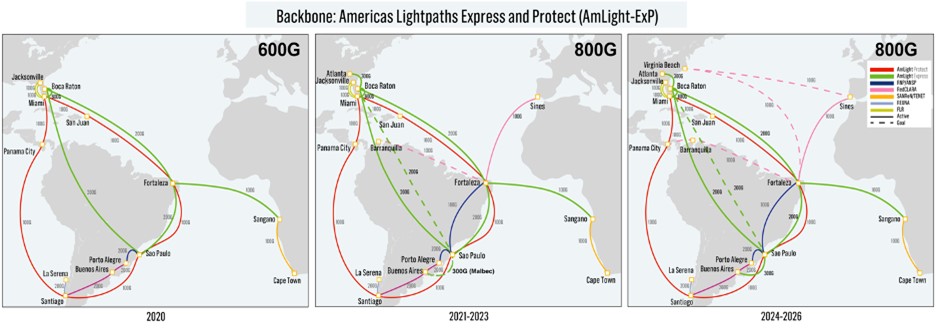Center for Internet Augmented Research receives $10.3M NSF grant to improve data sharing globally

FIU’s Division of IT’sCenter for Internet Augmented Research and Assessment (CIARA) has been awarded two five-year grants totaling $10.3 million for network infrastructure and software projects that will help scientists around the world share more data at a faster rate.
The funds will help CIARA continue to evolve the infrastructure of the AmLight intercontinental network and internet exchange points and help develop new software that will increase operational efficiency and better enable research that spans multiple continents.
One of the grants, for $6.5 million, will be used to fund the AtlanticWave-SDX and $3.8 million will go to the Americas Lightpaths Express and Protect project (AmLight-EXP). These projects, which were conceived by technology researchers and network engineers at CIARA, help researchers share large amounts of data quickly through a highspeed network that goes through North America, South America and Africa. Creating this strong dedicated network allows for data to be accessed quicker by scientists, educators, and students as well as research instruments that include the Vera Rubin Observatory in Chile, the High Luminosity Large Hadron Collider experiments in Brazil, and the Square Kilometer Array (SKA) in South Africa.
CIARA, a research center positioned to leverage advanced cyberinfrastructure for science research and education, was established in 2003 and has successfully bridged technology gaps between researchers and IT practitioners. CIARA also has provided scholarships for undergraduate and graduate students, especially underrepresented minorities, women and first-generation college students. CIARA supports interdisciplinary research, education and operations through its programs, making it unique to FIU and to higher education institutions, since only a handful of universities in the world have similar programs.
“We are incredibly proud of these grants and are confident they show CIARA’s commitment and dedication in bridging the gap between education and research,” said Robert Grillo, vice president and chief information officer of the Division of Information Technology. “We hope to continue our important work to better connect the world and share information.”
The AtlanticWave-SDX grant, which has been awarded to CIARA for the second time, aims to make network paths easy for scientists to use. The grant will introduce new capabilities, enabling Open Exchange Points (OXP) to react to unplanned network events. An OXP serves as meet points for connecting and facilitating the exchange of data between research and education networks. They are critical cyberinfrastructure in the transit of data over long geographical distances. For example, data from the Vera Rubin Observatory will transit 6 OXPs as it moves from the southern to northern hemispheres.
The AmLight-ExP network plans to increase in capacity and resiliency. By 2021-2023, the network’s goal is to increase bandwidth from Florida to Brazil, and Brazil to Colombia. AmLight partners in Latin America, in collaboration with the European Commission are adding a new Americas Lightpaths Express path from Fortaleza, Brazil to Sines, Portugal. The aggregate bandwidth capacity is planned to increase to 800 gigabytes-per-second, compared to its current capacity of 600 gigabytes-per-second.
From 2024 to 2026, scientists expect a growth in the research and education network fabric that links the continents across the Atlantic. The AmLight project envisions new network connections from Brazil to Virginia, and Virginia to Portugal, adding resiliency and capacity between the U.S., South America, and Europe. By 2026, the AmLight project aims to achieve 4.4 terrabytes-per-second of aggregate bandwidth capacity.
